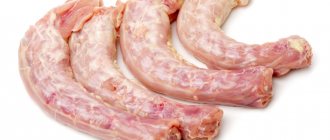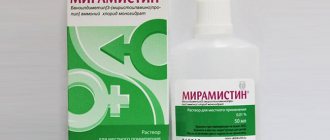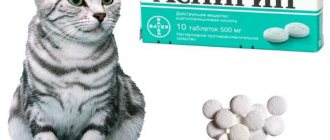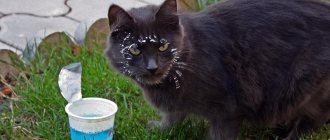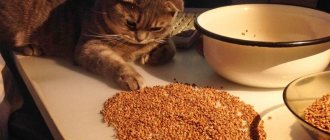Veterinarians believe that chicken meat is a healthy product for cats due to its high protein content, micro- and macroelements. The pet's diet should also contain by-products - kidneys, liver, hearts and stomach. Poultry is the healthiest because it does not contain antibiotics or salt, which is used to artificially increase weight.
Basic rules for healthy cat nutrition
- About 90% of the diet should consist of meat and offal.
- Cat dishes are served raw (with the exception of some products, which will be discussed separately) and at room temperature. It is advisable to defrost frozen portions at room temperature.
- After preparing raw meat portions, place them in the freezer for at least three days. Freezing kills almost all dangerous bacteria and parasites.
- Buy meat only from a trusted place.
- Food should contain bones or calcium supplements.
- Most of the diet should be offered in the form of pieces, since the pet must work with its jaws, tear and chew food. This is important for the cat’s health and prevents problems with teeth and gums.
- Clean water should be freely available.
- It is necessary to follow the feeding regimen and not exceed the portion size. An adult animal is fed twice a day, in the morning and late in the evening. The daily norm for a domestic, sedentary pet is approximately 50 g/kg of weight.
A cat's menu is much poorer than a human's. Cats are absolute predators; under natural conditions, very few grains and barely noticeable amounts of vegetables enter their stomachs. Therefore, no matter how healthy porridge, raw and baked vegetables may be for humans, they should not be included in your pet’s diet. We advise you to read the article, which describes in detail foods that are harmful to your cat’s health.
One of the easiest to prepare dishes that are most similar to natural food are raw chicken heads and necks. Some people do not believe and are even horrified that their cute cat is able to greedily bite into a chicken head and not choke on the bones. But it is the bones of the heads and necks that the cat will gnaw without harm to health. Moreover, such nutrition will bring a lot of benefits to the animal. Heads and necks require treatment before feeding, but this is not difficult to do.
WHY DO WE FEED ELITE SEARCH DOGS WITH MEAT, AND WHY DOES A CAT HAVE A CHICKEN HEAD.
I’m not a fan of writing posts on Facebook, but it’s too often that I, as a dog handler with two medical and veterinary degrees, have been asked the question: “Sergey, what should I feed my cat/dog?” And I decided to tell you why we don’t feed detection dogs dry food.
And everything is elementary. After drying, the dog completely loses its sense of smell. Yes, yes, exactly. The chemistry of the entire olfactory system changes. Such dogs are no longer fit for hard service for the benefit of humans. No sense of smell, no stamina. Of course, the dog smells the owner, the house, the neighbors. But taking the trail of a criminal is a completely different task, and a completely different job for the organism called “wolf.” It is “wolf”, since all dogs, without exception, have 99% of the wolf gene. And it doesn’t matter how this breed is bred - 99% will have wolf genetics.
After this argument, pet owners should no longer have any questions. After all, if a drug changes brain chemistry, then it is better not to use it. That is why all experiments on introducing the same sublimates into human food ended in failure. If an animal’s body can withstand 5–8 years of dry starvation, then the human body breaks down after only 18–20 months of using such “nutrition”: the kidneys and liver fail, the pancreas fails, the body becomes fat, ages and dies. The nervous system is especially affected. Believe me, there were a lot of such experiments, especially in the development of nutrition for space flights and in other areas. But... Drying is, first of all, convenience for the owner, and nothing more. Unfortunately, our smaller brothers cannot say NO to us. They are our hostages, our madness and soullessness.
So here it is. Firstly. Veterinary academies do not study the diet of cats and dogs. Surprised? That's why your veterinarian will ALWAYS TELL YOU TO FEED KIDS.
Secondly. The fairy tale that over the centuries of the existence of dogs and cats next to people, they have changed and began to eat our food, remains a fairy tale. No. Not a single cat or dog has changed genetics, the shape of the jaw, the tissue of the pancreas or stomach has not changed. The bite did not change and the teeth did not fall out. And most importantly, they did not develop new enzymes for digesting porridge, rice, potatoes and boiled meat. But diabetes mellitus, chronic renal failure, dysplasia, obesity, hepatosis and a bunch of everything appeared that we had not even heard about in our academies 30 years ago.
And now the third and most important part. What is the difference between drying and meat? Remember once and for all - there is NO MEAT in drying. None. This is a pure sublimate. These are peptides, protein particles. What's left of the meat. All. The question is closed. What is sublimate? The Internet can help you. There is a sea of information. Better yet, try eating only freeze-dried food for 7 days. I assure you that on the fifth day you will answer this question yourself. I experienced this personally when I participated in an experimental group to study life in the Arctic Circle with dogs. But the animal’s body is much more resilient than ours. And they can eat sublimate for a long time. A very long time.
And now the most important thing. What to feed. But here it’s up to you to decide. I don't mind drying. At certain moments it can help out. But... A little physiology. And this is the most important thing - read to the end!
Sublimate for an animal is actually digested, artificially fermented food. Remember that there is no meat, only peptides? That is, during production, the meat was fermented and then simply dried, adding a bunch of all sorts of ballast. This is why feed animals defecate every day. This is ballast coming out. On meat, the predator poops once every 2-3 days and is practically odorless. So here it is. When an animal eats dry food, the enzymatic apparatus of the pancreas is completely switched off! Why do we need enzymes if the food is already fermented? Now we have already received individuals that have an almost atrophied pancreas. These are cats and dogs in the 15th – 20th generation of “sushechniki” kennels. Although the alarm has already been sounded in the USA and our “meat” dogs are being taken to kennels.
Scary? Very. If such an animal is given meat, it will not eat. Why? Do you remember the reason why we don’t feed dry food to service dogs? Right. The areas of the brain responsible for the sense of smell are atrophied. And what caused this is NOT SPECIFIED in the food composition. So, this atrophy is transmitted genetically, just like the atrophy of the enzymatic apparatus. And even if the animal does eat the meat, then, I apologize, the defecation will be “farther away than it can be seen.” Why? But there are no enzymes. And there are no bacteria. There is nothing. It's clear, you'll shit yourself. This is where diabetes and fatty hepatosis come from.
"But! — you exclaim, “My Vaska has been at the stern for 15 years and everything is fine!” Yes! Your Vaska has the genetics of a mega-tenacious street cat. And he will live 18-21 years without problems. But the cat from the cattery is already in the 129th generation without enzymes. Therefore, at the age of 5, she will be dragged to the veterinarian with chronic renal failure. She will live for 10 years, perhaps, and die from early aging of the body 8 (at least!) years earlier (remember, I said above that the body ages in sublimates?). And the owner will leave a lot of money in that same veterinary clinic.
Well, now about CHICKEN HEADS. As someone who has been studying scientific research on the nutrition of obligate carnivores for a long time, I confirm that the most nutritious food for cats is the head. This is where omega-3, omega-6 and collagen are contained. And this is the most important thing for the reproductive system. That is why cats from nurseries now give birth to 1-3 kittens, and they are weakened, and a yard cat gives birth to 3-8 kittens. It is impossible to put valuable omega and collagen into drying. Therefore, the cat first of all eats the head and paws of the mouse; everything else, as a rule, remains if the cat is not hungry. The same goes for tigers and lions: the head and paws for themselves, and the carcass for the hyenas. It's a little different for dogs.
It is from the head and neck that the cat receives valuable calcium. I am silent about such an essential element as taurine. It is vital for cats, unlike dogs. At the academy, we studied that industrial taurine is absorbed by 3 - 7%. That's why cats need heads. And it’s the raw ones, there’s nothing valuable in the boiled ones. There is no need to be afraid of bones; these bones will never harm the animal. High acidity and special enzymes will dissolve them completely. But! If a cat eats dry food, it will not be able to digest these same heads and necks. Why? Because with such a diet, enzymes are not produced.
Moreover, when an animal is drying, the acidity of the gastric juice changes greatly. And the bones and meat can no longer be digested. This is why pets began to get so many viral infections. No acid - no protection. I assure you that acid will destroy any worm in a predator. Have you ever wondered why it is now recommended to deworm every 3 months? Because the acidity is zero, and the protection is also zero. And animals become infected with worms quite simply - you bring them home on your shoes. This is how worm eggs spread. They do not enter the body from meat, but from excrement. And dogs eat excrement on the street, which is what owners constantly complain to me about, not realizing that this is due to a lack of enzymes. They are not available in the dryer, but where can they be found? Right. And also in a garbage dump in rotting waste. This is not a “scavenger” dog, it is the survival instinct that drives it to eat carrion. But cats don’t need carrion; they have different enzymes.
In addition, from foreign nurseries we received a huge amount of feline leukemia, viruses and all sorts of nasty things that our cats and dogs did not suffer from. It was from there that a stream of disease carriers, raised on sublimates, poured into us. And believe me, as a doctor, I don’t remember such critical changes in animals even 10 years ago. And these changes are already considered the norm in veterinary medicine! They grow like a snowball. (It is considered normal when the entire dog kennel dies from corona. And what does the kennel feed on? Drying. Any more or less competent veterinarian will tell you that during corona, the food should be only meat! This is the law! And after 6 months the dog will be healthy.)
If you want to feed your cat correctly, then its food is muscle meat (namely muscles, not breast tenderloin), heart, stomachs, liver, neck and head of chickens, without which the animal will not receive calcium. But necks and heads are introduced only after complete restoration of the animal’s enzymatic apparatus. Cats and dogs should not be fed boiled food; they do not have the enzymes to digest such food. Only we humans have these enzymes; animals do not and never will. Cats do not need vegetables and cereals, this is also a guarantee of early old age. Dogs, on the other hand, need vegetables and things that “rot.” They have different enzymes than cats.
That's all in a nutshell. Remember that animals are not people. And their body is different, much stronger than ours. Do not compare them with yourself, then your pets will delight you for a long time. Of course, you can feed your pet a ready-made bag, dry food. But you understand that a child raised on French fries will have unhealthy genetics, diabetes, and will pass on his genes to his children, and those to their grandchildren. In the end, everything will be very sad. People have already understood that “we are what we eat.” But our smaller brothers turned out to be hostages of our ignorance and laziness. It is no longer surprising to me that breeders may not even know that dogs and cats were fed meat 20 years ago, and really think that from time immemorial they were fed dry food. It's scary, it's sad and it needs to change. Change before it's too late. Thank God that now there are entire nurseries of dogs and cats on a meat diet. And it pleases. Pleased with the results and healthy animals.
Bring goodness to the world!
Author: Sergey Danilov, dog handler. Text taken from open source:
https://www.facebook.com/permalink.php?story_fbid=428277461458148&id=100028276942422
The article was presented under the editorship of ARTCARTON. Some words/expressions of the Author have been replaced with synonyms that comply with our company policy.
How to Prepare Chicken Heads
Most often, such products are sold in frozen packages. Wait for the heads to thaw. Then you need to rinse them with cool water, cut off the beaks (they are too tough for a cat), and cut them in half lengthwise. This will not require noticeable physical effort.
If the head is small and the pet is large, you don’t have to cut it - more nutrients will be retained in the product. Then the halves are put into portioned boxes or cups. You can use plastic cups with a volume of 200 ml, the same volume as sour cream and mayonnaise boxes. One such serving will last a medium-sized adult domestic cat for the whole day.
The dangers of raw meat
In the wild, no one cooks for cats, and they eat their prey raw, along with all the offal, hair and other parts. However, this method of feeding has one danger: infection with helminths. It also threatens a domestic cat if you feed it raw meat. Freezing helps to cope with some types of helminths, but not all.
In addition, their eggs may be present in the meat, even if it has successfully passed veterinary control. The fact is that doctors test the product, but they do not assume that a person will consume it raw. And during the heat treatment, the eggs of most worms die. Meat is given to pets raw or semi-raw, so the danger of parasitic infestation is quite high.
We recommend reading the article about worms in cats and kittens to protect your pet.
How to prepare chicken necks
Necks, like heads, are often sold frozen and in packages.
As with the heads, they need to be thawed, rinsed with water and cleaned of skin and fat (the fat contained in any meat, but not visible to the naked eye, is quite enough). Then they need to be cut into pieces 1.5 - 2 cm long. The necks are quite easy to cut, you just need to try to guide the knife blade between the vertebrae. Instead of cutting into pieces, you can flatten the necks a little with a hammer. Then also distribute into portioned containers and freeze. For variety, it’s a good idea to form portions of heads and necks in a 50/50 ratio. Important!
A cat that is accustomed to human food or industrial feed is unlikely to be happy about changing its usual diet to heads and necks. You can learn how to correctly transfer a pet from one type of food to another in the article How to transfer a cat from commercial food to natural food (or vice versa).
Chicken heads for cats: the benefits of natural food
Cat owners may think that heads are a completely useless product. But this is only at first glance. Chicken combs and eyes contain large amounts of collagen, which is part of the protein. The brain contained in the heads is a source of fat and B vitamins. Soft bones act as a source of calcium for the body.
It is especially recommended to give chicken heads to kittens, whose bodies are developing and absorb nutrients well. This natural product is low in calories, contains protein, fat and beneficial microelements.
The calcium and phosphorus found in chicken heads are especially beneficial for nursing or pregnant cats. They give chicken heads to the cat to strengthen the gums and prevent the formation of tartar, which is facilitated by chewing bones.
Cooking fish
Only sea fish will do; river fish has too many bones. It needs to be boiled for a few minutes. Then cool and remove bones completely. One serving - no more than 150 g. You can put a raw quail egg in the fish. Although many cats simply love fish, it is not advisable to give it more than once every five days. Fish contains a lot of phosphorus and magnesium; its frequent presence in the diet upsets the balance of minerals in the cat’s body. This can provoke many diseases, primarily KSD.
In what form can cats be given meat, offal, eggs?
Not all types of meat are good for cats. Experts recommend feeding the animal chicken, turkey, lean parts of beef and lamb, rabbit, and veal. Pork, duck, goose, and excessively fatty meat are contraindicated for cats. It is advisable to buy products from trusted places, and be sure to ask for veterinary reports (without them, meat cannot be sold at all).
After purchasing, it is recommended to place it in the freezer for several days. Before feeding, scald with boiling water or cook a little.
The diet should also contain by-products. The most beneficial food for cats is liver. Unlike meat, it is recommended to give offal to your pet boiled. Chicken or beef liver should be boiled or well frozen, and scalded with boiling water before feeding. The first option is preferable, since the liver may contain helminth eggs and many harmful substances. Raw offal can also cause indigestion in cats, such as constipation or diarrhea.
Eggs also help provide the animal’s body with protein. There is no need to feed your cat raw eggs, as this can lead to salmonellosis. Cats eat boiled protein with pleasure. They also love yolk, but the quantity should be reasonable and you shouldn’t overdo it.
Chicken heads are not very healthy, but boiled chicken necks should be given. You can also offer your pet kidneys, hearts, and stomachs.
Cats do not need sinews, bones and other waste. Tubular bones can damage the animal's digestive tract. Meat should be given in the form of boneless fillet.
Cats can also have fish. This is also a useful and necessary protein for these animals. However, in the diet of castrated cats, the content of fish should be kept to a minimum. The fact is that this product is rich in phosphorus, and an excess of this element in the body of a castrated or sterilized cat provokes the development of urolithiasis.
Veterinarians recommend feeding cats sea fish.
River varieties contain more small bones and are more often infected with many types of helminths, most of which are dangerous for cats.
Meat mix
Any meat products in arbitrary proportions from those allowed are suitable for this dish. And the more of them, the better. For example: chicken breast, turkey and chicken stomachs, chicken heart. Everything is rinsed with cool water. Then the following are removed: from the hearts - pieces of fat, from the stomachs - hard connective fibers. After which the products are chopped into pieces measuring about 1 ╳ 1 cm. As in the case of heads and necks, the mixed cuts are placed in 200 ml portioned containers and sent for freezing.
How to feed and how long to cook chicken for a cat
How long should you cook chicken so that it is healthy for your cat? This must be done until it becomes soft. If the pieces are small, then 10-15 minutes of cooking will be enough. It is not advisable to give pieces from soup or side dishes because they contain salt and seasonings that cats do not need.
To be able to safely give boiled meat to cats, is it worth adhering to some rules for using chicken? Necessarily:
- buy meat in reliable stores, where it undergoes strict veterinary control;
- choose only fresh product, without unnecessary odors;
- Before feeding, remove all bones, tendons and skin from the meat that could cause the animal to choke;
- combine white and red meat. The breast is too dry to feed a cat. And the pulp of the thighs contains a higher content of fats, which have better nutritional properties;
- In order to feed your kitten boiled chicken, you need to make sure of its quality: does it contain additives? Before serving, cut the meat into the smallest pieces;
- add to meat and offal. But don’t get carried away (especially with the liver);
- If an animal develops an allergy or feels unwell, contact a veterinarian immediately.
Cats naturally eat raw meat. Therefore, many owners prefer to feed their pets uncooked chicken. However, this is very dangerous; there is a high probability of infecting the cat with salmonellosis. Almost a third of birds are carriers of this bacterium.
Signs of a cat being infected with salmonellosis are loose stools, vomiting, and lack of appetite. Therefore, if you want to feed your cat fresh meat, first cut it into pieces and freeze it. This way the bacteria will be destroyed and the pet will remain healthy. By-products left over from chicken should also be added to the cat's food. However, it is better that they also undergo heat treatment.
Chicken for kittens as a permanent food
To the question “Is it possible to feed chicken meat to kittens all the time?” Experts give mixed answers. But they adhere to the fact that in the first three months of life the diet should remain unchanged. Other products are added gradually and in small portions, but chicken meat must be present. You can replace it when the kitten grows up and adapts to heavier products.
Boiled or raw chicken meat is good for kittens for complete nutrition. It is cheap, accessible and easy to digest. If you follow all the rules, your pet will be happy with this dish and will grow up healthy and happy.
